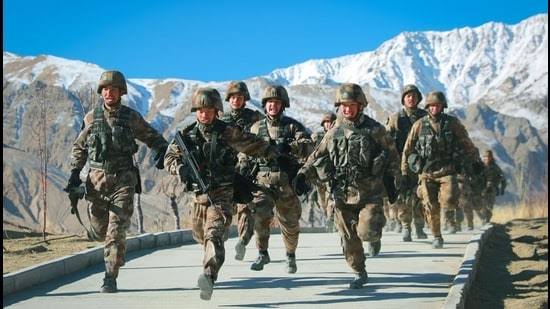Xi Reshaped China’s military, the Western Pacific, then made the Galwan blunder

China during the decade-long rule of Xi Jinping, built the world’s largest navy, revamped the globe’s biggest standing army, and amassed a nuclear and ballistic arsenal to take on the USA.
When Xi became commander-in-chief of the PLA in 2013, some reforms were already under way. The reforms had commenced in the 1990s, by Jiang Zemin on observing the action of US military during the Gulf War against the lowly Forces of Saddam. What forced him into action later was the Third Taiwan Strait Crisis.
China then commissioned its aircraft carrier, the Liaoning — a refurbished but still a rust bucket Soviet ship — and it’s own J-15 multi-role fighter aircraft, a poor copy a Sukhoi prototype. Then came Xi Jinping and PLA started consolidating its capabilities.
For years, after the Korean War and later the Vietnam China War, the People’s Liberation Army was seen as ill-equipped and ineffective Force and regarded by the Pentagon as “the world’s largest military museum”.
It was kitted out with ageing Soviet-derived weaponry, riddled with corruption and was a predominantly infantry force with a less-than-stellar record in foreign campaigns.
Today, China boasts of two active aircraft carriers, hundreds of long- and intermediate-range ballistic missiles, thousands of warplanes and a navy surpassing that the United State’s in number of Ships. Beijing’s military budget had kept increasing for 27 consecutive years, according to the Stockholm International Peace Research Institute.
All was fine for China and not only were the Pacific nations in awe but also the USA and Western Europe. Then out of the blue Xi Jinping made the most foolish move. His PLA started its old trick in Ladhak Region of India. Instead of finalizing and settling the Indo Tibet International Boundary and the China Tibet boundary, PLA tried to cross the LAC in Galwan area of Ladakh to grab some additional Indian territory ( it is in occupation of a large chunk since 1962).
However the Indian Army without firing a single shot turned the tables. PLA lost over 43 soldiers and an equal number as wounded. Thereafter Indian Army moved swiftly to re inforce the region matching / outnumbered the PLA and bewildering it totally.
It was for the first time that China realized that it was India which had the ability and the WILL POWER to match it in every field including military. That any wrong move across the Himalayas will not only be blunted but that India Army was now fully capable if liberating Tibet. It would also lead to cutting of its trade in the Indian Ocean Region thus choking its Jugular Vein. The PLAN may match the AUKUS forces in Western Pacific but had no capability to face the Indian Navy and the IAF in the Indian Ocean Region.
No wonder between Galwan and now Xi Jinping had to change the Western Theatre Commander four times. His own position in the politburo is now a bit shaky …..aka all the Coup rumors.
Now China’s neighbours in Western Pacific too are rushing to keep pace, Xi’s next five-year term is likely to see a quickening of Asia-Pacific arms race. From South Korea developing a blue-water navy, seeking Indian BRAHMOS missiles to Phillipines already concluding BRAHMOS deal, to Australia signing agreement for nuclear-powered submarines, weapons shopping has surged across the region.
According to figures from the London-based International Institute for Strategic Studies, Asia-Pacific defence spending passed $1 trillion last year alone. China, the Philippines and Vietnam have roughly doubled spending in the last decade. South Korea, is not far behind. Even Pakistan while carting its begging bowl is spending on weapons a lot.
Japan too is proposing record defence budgets and inching towards ending its long-standing “no first strike” policy, citing an “increasingly severe” security environment.
“All the key players in the Indo-Pacific region are responding to China’s military modernisation, basically as fast as they can,” said Malcolm Davis, a former Australian defence official now with the Australian Strategic Policy Institute.
After China launched a brief and partial blockade of Taiwan in August, a top US military officer tacitly conceded that preventing the real thing would not be easy, for Washington. No wonder every one looking towards India as a savior.
Meanwhile, China’s nuclear stockpile is increasing exponentially and — according to the Pentagon — can probably now be launched from land, sea and air, echoing the US nuclear triad.
According to the Bulletin of the Atomic Scientists, China has about 350 nuclear warheads, double the amount held during the Cold War. US intelligence predicts that this stockpile may double again to 700 by 2027. New nuclear missile silos are being built in the northwest of the country.
The PRC is now capable of combining its economic, diplomatic, military, and technological power to mount a sustained challenge to a international system run till now by the USA with help of its Western allies. Beijing will seek to reshape the international order to better align with its own desires and national interests.
Meanwhile South Korea plans to develop naval power capable of operating far from coastal waters, which experts say has little to do with the threat from rapidly arming North Korea. Australia plans to acquire eight nuclear submarines — with British and American help, part of the so-called AUKUS agreement.
There is also discussion in Canberra about obtaining hypersonic weapons, longer-range ballistic missiles and even state-of-the-art B-21 stealth bombers, capable of striking anywhere in the world. The days of the US Navy dominating the seas in the Western Pacific are fast approaching an end.
Only country now acting as the NORTH STAR ( Word third POLE …aagh ) for the entire world appears to be India.



